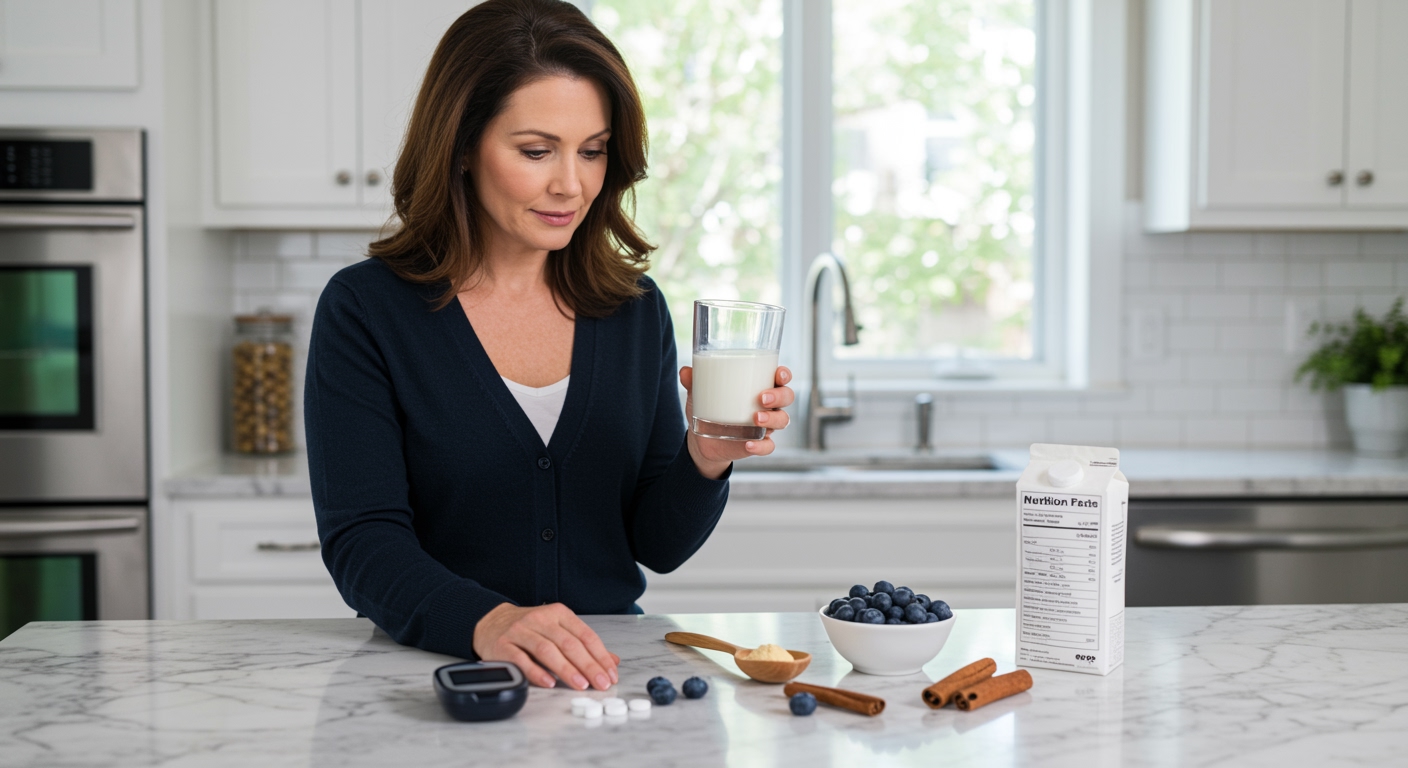✪ Key Takeaway: Lactose-free milk contains the same amount of natural milk sugars as regular milk and affects blood sugar similarly.
Introduction
You walk down the dairy aisle and see lactose-free milk sitting next to regular milk.
Maybe you think removing lactose makes it safer for your blood sugar levels.
Hi, I’m Abdur, your nutrition coach and today I’m going to explain exactly how lactose-free milk affects diabetes and whether it’s actually better for your blood sugar control.
What Exactly Is Lactose-Free Milk?
Lactose-free milk starts as regular cow’s milk with one important change.
Manufacturers add an enzyme called lactase that breaks down lactose into two simpler sugars.
These simpler sugars are glucose and galactose, which are the building blocks of lactose.
The total amount of sugar remains exactly the same as regular milk.
Think of it like breaking a chain into individual links – you still have the same amount of metal, just in a different form.
This process makes the milk easier to digest for people with lactose intolerance but does not reduce the sugar content.
✪ Fact: One cup of lactose-free milk contains about 12 grams of sugar, the same as regular milk.
How Does Lactose-Free Milk Affect Blood Sugar?
Your blood sugar responds to lactose-free milk in a very similar way to regular milk.
Both types of milk have a glycemic index of around 30-35, which is considered low to moderate.
The glucose and galactose in lactose-free milk enter your bloodstream and raise your blood glucose levels within 15-30 minutes.
Some people actually experience a slightly faster blood sugar rise with lactose-free milk.
This happens because the sugars are already broken down and ready for immediate absorption.
Regular milk requires your body to first break down lactose before absorption, which can slow the process slightly.
The difference is small but worth knowing if you monitor your blood sugar closely.
✪ Pro Tip: Test your blood sugar 1-2 hours after drinking lactose-free milk to understand your personal response.
Does The Protein In Milk Help With Blood Sugar?
Milk contains about 8 grams of protein per cup, which can help moderate blood sugar spikes.
Protein slows down the absorption of sugars and helps your body use insulin more effectively.
This protein benefit applies equally to both regular milk and lactose-free milk.
The casein and whey proteins in milk also help you feel full longer.
This satiety effect can prevent you from reaching for high-sugar snacks later.
However, the protein content alone cannot completely prevent blood sugar rises from the natural milk sugars.
✪ Note: Combining milk with fiber-rich foods like oatmeal can further slow sugar absorption.
Should You Choose Lactose-Free Milk For Diabetes?
The choice between regular milk and lactose-free milk should not be based on blood sugar concerns alone.
Both options affect your glucose levels in nearly identical ways.
Choose lactose-free milk only if you experience digestive problems with regular milk.
Symptoms like bloating, gas, or stomach cramps after drinking milk indicate lactose intolerance.
If you digest regular milk without problems, there is no diabetes-related reason to switch to the lactose-free version.
Both types provide the same nutritional benefits including calcium, vitamin D, and high-quality protein.
Focus on portion control rather than the type of milk you choose.
✪ Pro Tip: Stick to 4-6 ounces of milk per serving to keep blood sugar impact manageable.
What About Other Milk Alternatives?
Unsweetened almond milk contains only 1-2 grams of carbohydrates per cup compared to 12 grams in dairy milk.
This makes it a much better choice for blood sugar control.
Unsweetened soy milk contains about 4 grams of carbohydrates per cup and provides complete protein.
Coconut milk is higher in saturated fat but very low in carbohydrates when unsweetened.
Always check labels because many plant-based milks contain added sugars that can spike blood glucose.
The key word to look for is “unsweetened” on the package.
✪ Fact: Sweetened plant milks can contain 15-20 grams of added sugar per cup.
The Bottom Line
Lactose-free milk is not better than regular milk for diabetes management because both contain identical amounts of natural sugars that affect blood glucose similarly.
The lactose-free label creates a health halo that misleads people into thinking it’s automatically better for blood sugar control.
I would love to hear about your experiences with different types of milk and how they affect your blood sugar levels – please share your thoughts in the comments below.
References
At NutritionCrown, we use quality and credible sources to ensure our content is accurate and trustworthy. Below are the sources referenced in creating this article:
- PMC: Lactose intolerance and health
- Dairy Australia: Can I have lactose-free milk if I’m diabetic
- Nutrisense: Milk and blood sugar everything you need to know
- PMC: Dairy consumption and diabetes





